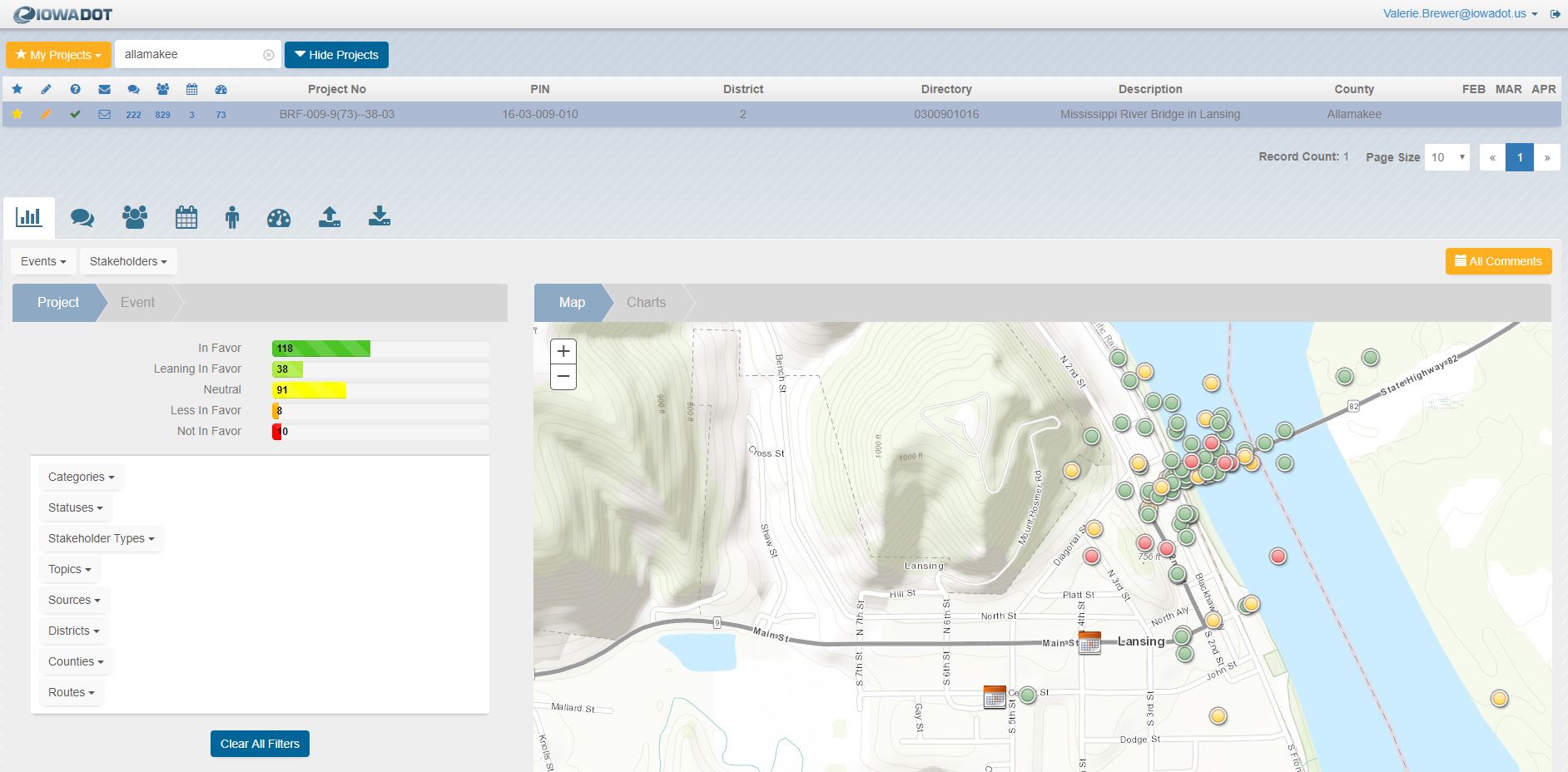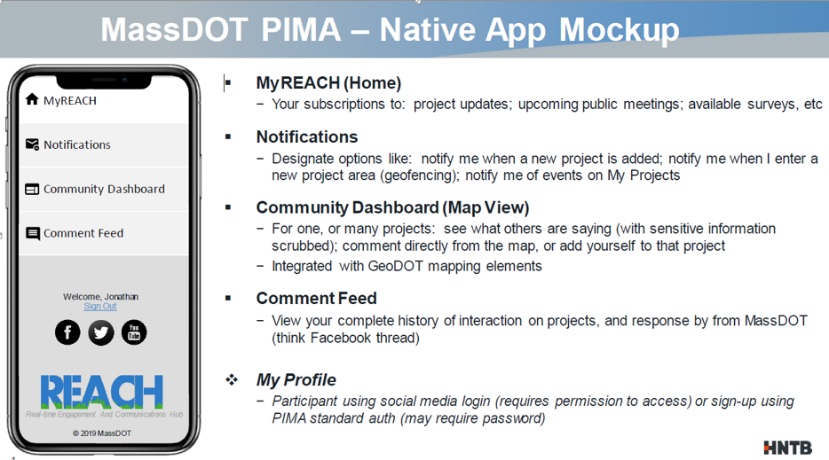A cloud-based web application that facilitates public involvement is helping the Iowa Department of Transportation make better-informed project decisions that reflect community input.
The Public Involvement Management Application (PIMA) is a virtual platform developed by IDOT and its consultant to facilitate gathering and processing of public input. The system provides a user-friendly interface that allows interested parties to electronically register and offer comments on projects, communicate concerns, and track progress on project decisions. The custom application allows IDOT to better manage its outreach efforts, improve customer service, strengthen project decision-making, and streamline the public involvement process. The intent by the Iowa DOT, from the very beginning, was to develop a tool that other agencies could benefit from.

The Federal Highway Administration is encouraging greater use of virtual public involvement practices as part of its Every Day Counts initiative. According to FHWA, such practices involve use of digital technology to engage individuals or to visualize projects and plans. Virtual applications like PIMA can facilitate access to project information, improve collaboration, and expand public engagement beyond traditional approaches, such as in-person public meetings. Leveraging technology for improved public outreach also can help save money and staff time, increase transparency, and accelerate project delivery.
Iowa DOT began developing PIMA in 2014 to address challenges due to staff reductions, according to Brad Hofer, Director of IDOT’s Right of Way Bureau. The agency sought to leverage technology as a way to simplify and improve the public involvement process while still meeting regulatory requirements.
The PIMA tool was developed a little bit at a time, as the agency had the resources to dedicate to it, Hofer said. Large-scale development began with a pilot in 2015, followed by broader testing, use, and expansion of the application in 2016, and enhancements to online meetings and offline capabilities from 2017-2018. Currently, the system is used on all IDOT projects. As of February 2020, PIMA has been used on over 220 public involvement events. The system includes about 34,000 stakeholders, and IDOT has used it to receive and respond to more than 2,670 comments.
Using the PIMA Platform
To use the system, citizens attending public meetings register on an easy-to-use, dedicated tablet. They can also register through Internet links and QR codes displayed at public meetings, using their personal handheld device. Attendees can find their contact information from data pre-populated by the IDOT, or they are prompted to enter their own contact information. The system includes a form on which users can submit comments, indicate their level of support for the project, and subscribe to future information for the project. Users can geospatially “pin” their comment on an interactive map to identify the location of their concerns and questions. IDOT also solicits and accepts comments by more traditional means such as postal mail, email, phone, or in person.

From IDOT’s perspective, the tool allows the agency to more efficiently manage public involvement events and activities, keeping a record of all comments that come into the system and allowing email responses to be sent out. The system also can be used to conduct online project meetings, during which comments may be submitted electronically.
Benefits
PIMA has allowed IDOT to expand the scope and reach of public information efforts in terms of the number of people reached for each project, the number and types of projects for which public input can be collected and tracked, and the ability to analyze comments throughout the development process.
In the past, public involvement efforts were targeted primarily at 1% to 2% of IDOT’s projects – those with environmental assessments or environmental impact statements. “Now the public has an opportunity to see every project we are developing and comment on any project – from a programmatic categorical exclusion, to the most complicated EIS,” Hofer said. Comments also may be submitted through all project phases, including planning, design, construction, and post-construction.
In addition to facilitating outreach, the PIMA tool offers extensive analytics capability, allowing the agency to better serve communities for future public outreach events. For each public involvement event, a dashboard can be viewed showing the number of comments, level of support, average response time, and number of attendees (below, left). Comments can be viewed on a map and are color coded to show level of support (below, right).
“Before PIMA, we had no way to analyze public input for a particular project. Now, it’s so much easier for the public to comment and for the comments to actually go to the people who are developing the project,” Hofer said. The system also provides transparency and accountability – allowing anyone to view all comments on a given project. “Not only are we accountable for what we say, but the public is accountable for what they say,” Hofer added.
In some cases, giving stakeholders more of a voice has improved public support for the project by providing a better understanding of project decisions, according to IDOT public involvement manager Valerie Brewer. For example, PIMA illustrates how public comments on the Black Hawk Bridge Replacement Project in Lansing, Iowa, went from primarily negative at the start of the project, to overwhelmingly positive after a series of public meetings and outreach efforts.
Sharing with State DOTs
The system has been demonstrated at various venues and in one-on-one presentations with more than a dozen state DOTs. IDOT is encouraging other state DOTs to use its system – asking that any enhancements are shared. States that want to use the application can enter into a memorandum of agreement with IDOT to obtain the proprietary software.
“We were hoping several states would take it and run with it,” Hofer said, and through sharing of improvements IDOT would get some of the benefits back. “It’s starting to pay off now,” he said.
So far, IDOT has agreements with two state DOTs – Georgia and Massachusetts. Massachusetts DOT “has taken PIMA to the next level in terms of innovating,” Hofer said. MassDOT enhancements include a native application for use on mobile devices. The app allows users to track projects, receive notifications, and provide and view comments. It also includes mapping capability and can integrate with social media.
IDOT also allows its developer (HNTB Corp.) to contract with other state DOTs to use the platform on a project-specific basis, and several additional states have done so.

Mockup of MassDOT’s native application derived from PIMA. (Image MassDOT)
Challenges and Lessons Learned
A primary challenge was getting buy-in from users, according to IDOT public information manager Jon Rees. But once district planners saw the benefits of having all comments and data in one place, as well as analytics capabilities, they grew to like it and use it.
“Finding the time to develop the tool, on top of daily responsibilities, was also a major challenge,” Rees said. “The fact that we share this tool with other states at no charge is a huge benefit,” he said.
Hofer agreed, noting that once states obtain the software, “it’s essentially their instance of it, and they can innovate on it all they want. They don’t have to come to us for changes. We only ask that they share those changes with the network of states that are implementing this.”
“We all say being responsive to our citizens is important – to be transparent and to communicate like we ought to,” Hofer added. “PIMA took us to another level in being able to do that.”
For more information on sharing the platform, contact Tamara Nicholson, Director of Iowa DOT’s Office of Location and Environment, at [email protected]. For general information on PIMA, link to IDOT’s PIMA Public Access Portal or contact Jon Rees at [email protected] or Valerie Brewer at [email protected].